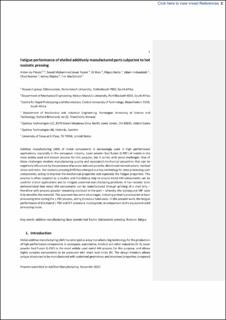| dc.contributor.author | Du Plessis, Anton | |
| dc.contributor.author | Razavi, Seyed Mohammad Javad | |
| dc.contributor.author | Wan, Di | |
| dc.contributor.author | Berto, Filippo | |
| dc.contributor.author | Imdaadulah, Adam | |
| dc.contributor.author | Beamer, Chad | |
| dc.contributor.author | Shipley, James | |
| dc.contributor.author | MacDonald, Eric | |
| dc.date.accessioned | 2022-03-30T06:02:52Z | |
| dc.date.available | 2022-03-30T06:02:52Z | |
| dc.date.created | 2022-01-14T15:18:54Z | |
| dc.date.issued | 2022 | |
| dc.identifier.issn | 2214-8604 | |
| dc.identifier.uri | https://hdl.handle.net/11250/2988441 | |
| dc.description.abstract | Additive manufacturing (AM) of metal components is increasingly used in high performance applications, especially in the aerospace industry. Laser powder bed fusion (L-PBF) of metals is the most widely used and mature process for this purpose, but it comes with some challenges. One of these challenges involves manufacturing quality and associated mechanical properties that can be negatively influenced by the presence of process-induced porosity, directional microstructure, residual stress and more. Hot isostatic pressing (HIP) has emerged as a key technology for post-processing such components, acting to improve the mechanical properties and especially the fatigue properties. This process is often required as a routine and mandatory step to ensure metal AM components can be used for critical applications and to mitigate potential manufacturing problems. It has recently been demonstrated that metal AM components can be manufactured through printing of a shell only – therefore with process powder remaining enclosed in the part – whereby the subsequent HIP cycle fully densifies the material. This approach has some advantages, including primarily a reduction in laser processing time during the L-PBF process, acting to reduce total costs. In this present work, the fatigue performance of this hybrid L-PBF and HIP process is investigated, in comparison to the equivalent solid processing route. | en_US |
| dc.language.iso | eng | en_US |
| dc.publisher | Elsevier | en_US |
| dc.title | Fatigue performance of shelled additively manufactured parts subjected to hot isostatic pressing | en_US |
| dc.type | Journal article | en_US |
| dc.type | Peer reviewed | en_US |
| dc.description.version | acceptedVersion | en_US |
| dc.rights.holder | This article will not be available until March 2024 due to publisher embargo - © 2022. This manuscript version is made available under the CC-BY-NC-ND 4.0 license | en_US |
| dc.source.volume | 51 | en_US |
| dc.source.journal | Additive Manufacturing | en_US |
| dc.identifier.doi | 10.1016/j.addma.2022.102607 | |
| dc.identifier.cristin | 1981432 | |
| cristin.ispublished | true | |
| cristin.fulltext | preprint | |
| cristin.fulltext | postprint | |
| cristin.qualitycode | 1 | |
